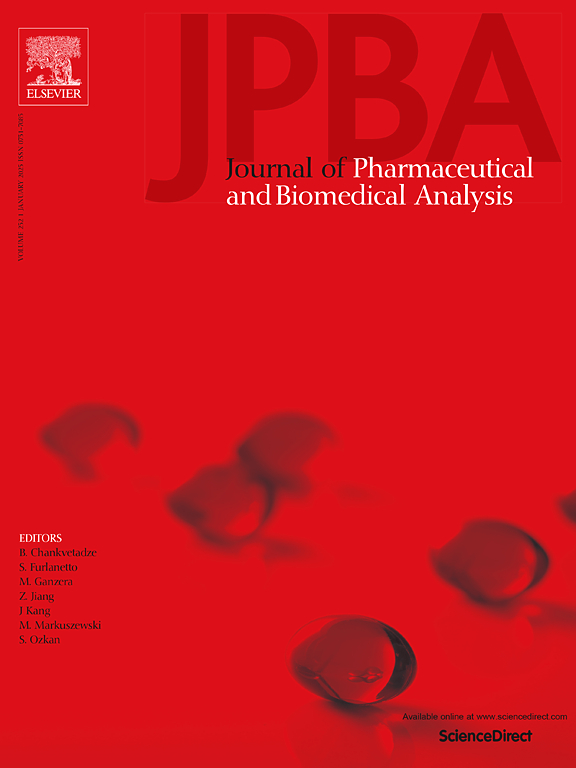推进激光直接红外(LDIR)成像的药物片剂分析
IF 3.1
3区 医学
Q2 CHEMISTRY, ANALYTICAL
Journal of pharmaceutical and biomedical analysis
Pub Date : 2025-04-11
DOI:10.1016/j.jpba.2025.116897
引用次数: 0
摘要
激光直接红外光谱(LDIR)成像是一种新兴的振动光谱技术,通过使用反射光谱在几分钟甚至几秒钟内捕获关键的物理化学性质,如化学特性,粒度,形状和成分分布,从而实现快速表面成像。尽管具有优势,但LDIR成像技术仍处于发展阶段,特别是在理解方法参数方面,例如峰和基线点的波数选择以及药物分析的适当步长(像素)。在这项研究中,使用LDIR成像分析了内部制备和市售的片剂,以评估方法开发选项的影响,特别是步长与数据采集时间之间的关系。采集了高光谱反射模式下的LDIR图像,并与拉曼显微镜下的LDIR图像进行了比较,验证了LDIR图像的准确性。研究结果强调在方法开发过程中需要仔细选择波数。评价片剂的LDIR图像与拉曼映射和高光谱模式数据集显示出良好的一致性,尽管LDIR图像中颗粒的平均Feret直径始终较小(14-40 %,测试片剂中的活性药物成分)。总的来说,LDIR显示出作为一种有价值的光谱成像技术在制药应用中的巨大潜力。本文章由计算机程序翻译,如有差异,请以英文原文为准。
Advancing pharmaceutical tablet analysis with laser direct infrared (LDIR) imaging
Laser direct infrared spectroscopy (LDIR) imaging is an emerging vibrational spectroscopic technique that enables rapid surface imaging by using reflectance spectra to capture critical physicochemical properties, such as chemical identity, particle size, shape, and distribution of components, within minutes or even seconds. Despite its advantages, LDIR imaging technology is still in its developmental stages, particularly in understanding method parameters such as the selection of wavenumber for peak and baseline points and the appropriate step size (pixels) for pharmaceutical analysis. In this study, in-house prepared and commercially available tablets were analyzed using LDIR imaging to assess the effects of method development options, particularly the relationship between step size and data acquisition time. Hyperspectral reflectance mode LDIR images were also collected and compared with those obtained from Raman microscopy to validate the accuracy of the LDIR images. The findings emphasize the need for careful wavenumber selection during method development. LDIR images for the evaluated tablets showed good agreement with Raman mapping and hyperspectral mode data sets, although the mean Feret diameter of particles was consistently smaller (14–40 % for active pharmaceutical ingredients (APIs) in the tested tablets) in the LDIR images. Overall, LDIR demonstrates strong potential as a valuable spectroscopic imaging technology for pharmaceutical applications.
求助全文
通过发布文献求助,成功后即可免费获取论文全文。
去求助
来源期刊
CiteScore
6.70
自引率
5.90%
发文量
588
审稿时长
37 days
期刊介绍:
This journal is an international medium directed towards the needs of academic, clinical, government and industrial analysis by publishing original research reports and critical reviews on pharmaceutical and biomedical analysis. It covers the interdisciplinary aspects of analysis in the pharmaceutical, biomedical and clinical sciences, including developments in analytical methodology, instrumentation, computation and interpretation. Submissions on novel applications focusing on drug purity and stability studies, pharmacokinetics, therapeutic monitoring, metabolic profiling; drug-related aspects of analytical biochemistry and forensic toxicology; quality assurance in the pharmaceutical industry are also welcome.
Studies from areas of well established and poorly selective methods, such as UV-VIS spectrophotometry (including derivative and multi-wavelength measurements), basic electroanalytical (potentiometric, polarographic and voltammetric) methods, fluorimetry, flow-injection analysis, etc. are accepted for publication in exceptional cases only, if a unique and substantial advantage over presently known systems is demonstrated. The same applies to the assay of simple drug formulations by any kind of methods and the determination of drugs in biological samples based merely on spiked samples. Drug purity/stability studies should contain information on the structure elucidation of the impurities/degradants.

 求助内容:
求助内容: 应助结果提醒方式:
应助结果提醒方式:


